| |
Comorbidities Prevalence & Clustering Together in 2 European Aging/HIV Cohorts – POPPY & AGEHIV
|
| |
| |
Download the PDF here
CROI: Aging At CROI 2019 - (04/02/19)
NATAP dedicated Aging & HIV website
Aging & HIV: Gilead Funds 30 Organizations with $17 Million; ViiV Project - "Aging/HIV has become the #1 issue from at least a clinical perspective" - (04/17/19)
Why are people with HIV considered "older adults" in their fifties? "immunosenescence" - (04/17/19)
New VIDEO - Staying Golden: Aging With HIV - (04/05/19)
Victor Valcour plenary - CROI: I Keep Forgetting HIV, Aging, and Cognitive Disorders - (03/29/19)
Working memory revived in older adults by synchronizing rhythmic brain circuits - (04/09/19)
Reported by Jules Levin
These 2 reports, poster at CROI and publication last November look at comorbidities co-occurrence, they report PLHW tend to get certain types of comorbidities that may cluster together and they discuss certain life stye or demographic risk factors that may be associated with these clusters of comobidities. For example, see poster below - MSMs and cancers were associated, CVD is associated with BMI. Current/past IDU is associated with mental health problems. Jules
In POPPY PLWH, the prevalence of comorbidities ranged from 1.6% (encephalitis) to 42.6% (gonorrhea) (Table 1), with also depression (34.2%), syphilis (30.4%), and dyslipidemia (27.3%) among the most prevalent comorbidities. In total, 97.2% of all POPPY PLWH and 98.6% of older POPPY PLWH reported ≥1 comorbidity with a median (IQR) of 5 (3–7) and 6 (3–8) comorbidities per individual, respectively. Of the comorbidities considered in AGEhIV PLWH, hypertension (43.1%), osteopenia/osteoporosis (42.6%), lipodystrophy/lipoatrophy (32.1%), and candidiasis (31.9%) were the most common (Supplementary Table 2). Overall, 98.7% had ≥1 comorbidity, with a median (IQR) of 5 (3–7) comorbidities per individual.
Nonrandom Associations Between Comorbidities
Significant nonrandom associations, based on the Somers’ D statistic, among POPPY PLWH are depicted in Figure 1 (all pairwise Somers’ D are reported in the Supplementary Data). Nonrandom associations within several cardiovascular diseases (CVDs) were significant (top-right part of Figure 1); these included hypertension, angina, heart failure, type 2 diabetes, lipodystrophy/lipoatrophy, dyslipidemia, transient ischemic attack (TIA), coronary artery bypass graft (CABG), myocardial infarction (MI), and renal problems. Other strong nonrandom associations were identified within mental health problems (depression, anxiety, and panic attacks), with depression also being associated with sleeping problems and irritable bowel syndrome (IBS), cancers (hematological cancer with both solid organ and skin cancer), and sexually transmitted diseases (STDs; in particular gonorrhea, chlamydia, lymphogranuloma venereum [LGV], syphilis, and hepatitis C virus).
at CROI: IMPACT AND DETERMINANTS OF COMORBIDITY CLUSTERS IN PEOPLE LIVING WITH HIV

------------------------------
Patterns of Co-occurring Comorbidities in People Living With HIV
Open Forum Infectious Diseases November 2018
The aims of this study were to identify common patterns of comorbidities observed in people living with HIV (PLWH), using a data-driven approach, and evaluate associations between patterns identified.
This study explored associations between a wide range of comorbidities and identified common patterns occurring in 2 independent cohorts of PLWH. Our findings suggest that, in PLWH, comorbidities do not co-occur at random and, in general, are likely to cluster in specific patterns, some of which are consistent across different cohorts. In particular, we found that patterns of CVDs, metabolic disorders, STDs, and mental health problems are present in treated PLWH from both the UK/Ireland and the Netherlands. Our study adds to the 2 previous studies reporting patterns of comorbidities identified through purely statistical approaches [14, 15] by considering a wider range of comorbidities and validating the results in 2 independent cohorts.
Interestingly, there was some overlap between patterns, as suggested by significant correlations between patterns’ severity scores. In particular, mental health problems appeared to be associated with almost all other patterns, including those of CVDs, STDs, and metabolic disorders. Although these findings are in line with reports of the strong link between physical and mental health [28, 29], the nature of these associations is likely to be bidirectional. Poor physical health can lead to an increased risk of developing mental health problems, but, at the same time, individuals with several mental health disorders are often more likely to experience physical health conditions [30].
Abstract
Background
The aims of this study were to identify common patterns of comorbidities observed in people living with HIV (PLWH), using a data-driven approach, and evaluate associations between patterns identified.
Methods
A wide range of comorbidities were assessed in PLWH participating in 2 independent cohorts (POPPY: UK/Ireland; AGEhIV: Netherlands). The presence/absence of each comorbidity was determined using a mix of self-reported medical history, concomitant medications, health care resource use, and laboratory parameters. Principal component analysis (PCA) based on Somers’ D statistic was applied to identify patterns of comorbidities.
Results
PCA identified 6 patterns among the 1073 POPPY PLWH (85.2% male; median age [interquartile range {IQR}], 52 [47–59] years): cardiovascular diseases (CVDs), sexually transmitted diseases (STDs), mental health problems, cancers, metabolic disorders, chest/other infections. The CVDs pattern was positively associated with cancer (r = .32), metabolic disorder (r = .38), mental health (r = .16), and chest/other infection (r = .17) patterns (all P < .001). The mental health pattern was correlated with all the other patterns (in particular cancers: r = .20; chest/other infections: r = .27; both P < .001). In the 598 AGEhIV PLWH (87.6% male; median age [IQR], 53 [48–59] years), 6 patterns were identified: CVDs, chest/liver, HIV/AIDS events, mental health/neurological problems, STDs, and general health. The general health pattern was correlated with all the other patterns (in particular CVDs: r = .14; chest/liver: r = .15; HIV/AIDS events: r = .31; all P < .001), except STDs (r = –.02; P = .64).
Conclusions
Comorbidities in PLWH tend to occur in nonrandom patterns, reflecting known pathological mechanisms and shared risk factors, but also suggesting potential previously unknown mechanisms. Their identification may assist in adequately addressing the pathophysiology of increasingly prevalent multimorbidity in PLWH.
Individual Comorbidities
In POPPY PLWH, the prevalence of comorbidities ranged from 1.6% (encephalitis) to 42.6% (gonorrhea) (Table 1), with also depression (34.2%), syphilis (30.4%), and dyslipidemia (27.3%) among the most prevalent comorbidities. In total, 97.2% of all POPPY PLWH and 98.6% of older POPPY PLWH reported ≥1 comorbidity with a median (IQR) of 5 (3–7) and 6 (3–8) comorbidities per individual, respectively. Of the comorbidities considered in AGEhIV PLWH, hypertension (43.1%), osteopenia/osteoporosis (42.6%), lipodystrophy/lipoatrophy (32.1%), and candidiasis (31.9%) were the most common (Supplementary Table 2). Overall, 98.7% had ≥1 comorbidity, with a median (IQR) of 5 (3–7) comorbidities per individual.
Nonrandom Associations Between Comorbidities
Significant nonrandom associations, based on the Somers’ D statistic, among POPPY PLWH are depicted in Figure 1 (all pairwise Somers’ D are reported in the Supplementary Data). Nonrandom associations within several cardiovascular diseases (CVDs) were significant (top-right part of Figure 1); these included hypertension, angina, heart failure, type 2 diabetes, lipodystrophy/lipoatrophy, dyslipidemia, transient ischemic attack (TIA), coronary artery bypass graft (CABG), myocardial infarction (MI), and renal problems. Other strong nonrandom associations were identified within mental health problems (depression, anxiety, and panic attacks), with depression also being associated with sleeping problems and irritable bowel syndrome (IBS), cancers (hematological cancer with both solid organ and skin cancer), and sexually transmitted diseases (STDs; in particular gonorrhea, chlamydia, lymphogranuloma venereum [LGV], syphilis, and hepatitis C virus).
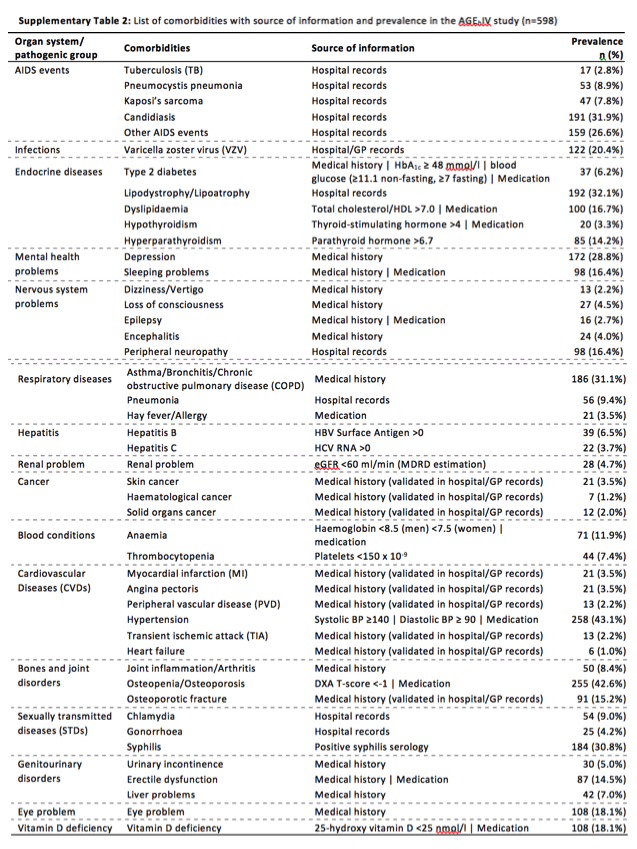
Most of these nonrandom associations were maintained when the analysis was restricted to older POPPY PLWH (Figure 2A). In addition, a strong nonrandom positive association was found between panic attacks and asthma/bronchitis/chronic obstructive pulmonary disease (COPD), and a significantly lower than expected co-occurrence of hypertension and LGV. A few of these significant nonrandom associations were also found in the AGEhIV PLWH (Figure 2B), namely the associations between MI, angina and hypertension, those of dyslipidemia with TIA, MI and type 2 diabetes, and those between gonorrhea and chlamydia and between angina and heart failure.
Patterns of Comorbidities
The PCA in POPPY PLWH yielded 6 components explaining 24.4% of the total variation in the original 65 comorbidities. Correlations between comorbidities and each pattern are reported in the Supplementary Data, with Table 3 reporting only comorbidities with a correlation >0.4 with each pattern. The first PC accounted for 6.2% of the variance and encompassed CVDs such as angina, CABG, MI, heart failure, hypertension, peripheral vascular disease (PVD), and renal problems. The second PC, with strong correlations with STDs (gonorrhea, chlamydia, LGV, syphilis, and hepatitis C), accounted for 5.0% of the variability. The third PC strongly correlated with mental health problems (depression, anxiety, and panic attacks). The fourth and fifth PCs included cancers (hematological, skin, and solid organ cancer) and metabolic disorders (dyslipidemia, lipodystrophy/lipoatrophy, and hypertension), respectively. Finally, the sixth PC had the strongest correlation with chest problems (pneumonia, asthma/bronchitis/COPD, and chest infection), cytomegalovirus, and dizziness/vertigo.
In the older POPPY PLWH, the PCA returned 6 components explaining 24.8% of the total variability (Table 3; Supplementary Data). Several components were similar to those found among all POPPY PLWH: CVDs (first PC), STDs (second PC), cancers (fourth PC), and metabolic disorders (fifth PC). Similar to the “mental health” pattern in all POPPY PLWH, the third PC included mental health problems but with the addition of asthma/bronchitis/COPD and dizziness/vertigo. Finally, the sixth PC correlated with hypothyroidism (0.46) and other AIDS events.
Some of the 6 patterns returned by the PCA in the AGEhIV PLWH, explaining 34.2% of the total variance, resembled those identified in the older POPPY PLWH. The first PC correlated with CVDs (dyslipidemia, hypertension, PVD, angina pectoris, and MI). The second PC included chest (asthma/bronchitis/COPD) and liver problems (with hepatitis B). The third and fourth PCs were related to HIV/AIDS events and mental health/neurological problems, respectively. The fifth included STDs (gonorrhea, chlamydia, and syphilis), and the sixth encompassed disorders associated with general health such as anemia, vitamin D deficiency, hyperparathyroidism, and heart failure.
Correlations Between Patterns
Correlations between patterns’ severity scores are reported in Table 4. In all POPPY PLWH, positive correlations of severity scores in the CVDs pattern were strongest with scores in the cancer (r = .32) and metabolic patterns (r = .38) and moderate with those in the mental health (r = .16) and chest/other infection (r = .17) patterns (all P < .001). A significant negative correlation was also found between the CVDs and STDs patterns (r = –.10; P = .001), suggesting that PLWH with a higher burden of CVDs tend to have a lower number of STDs and vice versa. Generally, the severity of the mental health pattern was positively correlated with the severity of all other patterns, with the strongest evidence for cancers (r = .20; P < .001) and chest and other infections (r = .27; P < .001). Chest/other infections was also positively associated with cancers and metabolic patterns (r = .27 and r = .25, respectively; both P < .001).
In the older POPPY PLWH, higher CVDs severity scores were correlated with higher mental health/asthma (r = .22), cancer (r = .26), and metabolic (r = .34) scores (all P < .001). Mental health/asthma scores also correlated with all the remaining patterns, with correlations ranging between 0.11 (with STDs) and 0.25 (with other). Among AGEhIV PLWH, association of CVDs was strongest with HIV/AIDS events (r = .18; P < .001) and general health problems (r = .14; P < .001) but weak with other patterns. A higher severity of the general health pattern was correlated with higher severity in all the other patterns (CVDs; chest/liver: r = .15; P < .001; HIV/AIDS events: r = .31; P < .001; mental health/neurological problems: r = .08; P = .05) but not with STDs (r = –.02; P = .64)
BACKGROUND:
Widespread access to combination antiretroviral therapy (cART) has led to a marked improvement in the survival and life expectancy of people living with HIV (PLWH) [1, 2] and to an increase of proportions of PLWH over the age of 50 years in most settings [3]. As a result of this demographic shift, a high prevalence of multimorbidity, defined as the occurrence of multiple comorbidities within the same individual, has been reported among PLWH with implications for health outcomes and functional status [4–6]. However, knowledge about how individual comorbidities distribute or co-occur in the same individual among PLWH remains limited.
Managing individuals with multiple acute or chronic comorbidities is typically more challenging than managing individuals with a single condition [7, 8]. Current HIV guidelines [9, 10] recommend close monitoring of cardiovascular, metabolic, liver, kidney, and bone health and regular assessment of drug–drug interactions. Investigating common patterns, associations, interactions, and possible synergies between comorbidities could support further development of targeted interventions and guidelines for prevention and management of PLWH experiencing multiple comorbidities.
Assessment of patterns of comorbidities is complicated by “coincidental comorbidity”—the co-occurrence of 2 or more comorbidities by chance [11]. The identification of comorbidities that are more likely to occur together than would be expected by chance can reveal disease–disease interactions or indicate shared etiologies between comorbidities. It is therefore important to separate coincident (random) comorbidity from nonrandom comorbidity. Modern statistical methods allow the exploration of the underlying structure in the distribution of comorbidities, giving an overall picture of the broad pattern of how comorbidities cluster in a particular population.
A recent report from the HIV and Aging Working Group called for the collection of better observational data to identify common clusters (patterns) of comorbidities among PLWH and their impact on treatment and disease outcomes [12]. Although some studies have attempted to do so in the general population using statistical approaches without any a priori hypothesis [13], to the best of our knowledge, only 2 studies have focused on PLWH [14, 15]. These studies considered up to 15 comorbidities but were unable to include the broad spectrum of comorbidities and medical conditions that are commonly reported by PLWH, and therefore the patterns among a more comprehensive set of comorbidities observed in PLWH remain unclear.
The aims of this study were (1) to explore (noncoincidental) associations between comorbidities in 2 independent cohorts of PLWH, (2) to investigate common patterns of comorbidities using a data-driven statistical approach, and (3) to evaluate associations between the patterns identified.
This study is based on data from 2 European cohorts of PLWH: the POPPY study in the UK/Ireland and the AGEhIV study in the Netherlands. Both studies aimed to investigate the effects of aging and comorbidities in PLWH and assessed a wide range of comorbidities, as detailed below.
The POPPY Study
The POPPY study recruited 2 cohorts of PLWH: an “older” group of PLWH aged ≥50 years and a younger group of PLWH aged 18–50 years, as described previously [16]. Inclusion criteria were documented presence of HIV infection, white or black-African ethnicity, likely route of HIV acquisition via sexual exposure, and ability to comprehend the study information leaflet. The younger group of PLWH was frequency-matched on gender, ethnicity, sexual orientation, and location (in or out of London) to the older PLWH. In addition, the study recruited a group of HIV-negative individuals aged ≥50 years, who was not included in the present analysis. Participants were recruited from HIV outpatient clinics between April 2013 and January 2016. The study was approved by the UK National Research Ethics Service (NRES; Fulham, London, UK, number 12/LO/1409). All participants provided written informed consent.
The AGEhIV Study
Study Participants
The AGEhIV study recruited PLWH aged ≥45 years from the HIV outpatient clinic of the Academic Medical Centre in Amsterdam, the Netherlands [17], between October 2010 and September 2012. Inclusion criteria were age ≥45 years and laboratory-confirmed presence of HIV infection. Although a control group of HIV-negative individuals was also enrolled in the study, these individuals were not included in the present analysis. The study protocol was approved by the local ethics review committee (ClinicalTrial.gov identifier NCT01466582). All participants provided written informed consent.
DISCUSSION
This study explored associations between a wide range of comorbidities and identified common patterns occurring in 2 independent cohorts of PLWH. Our findings suggest that, in PLWH, comorbidities do not co-occur at random and, in general, are likely to cluster in specific patterns, some of which are consistent across different cohorts. In particular, we found that patterns of CVDs, metabolic disorders, STDs, and mental health problems are present in treated PLWH from both the UK/Ireland and the Netherlands. Our study adds to the 2 previous studies reporting patterns of comorbidities identified through purely statistical approaches [14, 15] by considering a wider range of comorbidities and validating the results in 2 independent cohorts.
Nonrandom associations between CVDs such as angina, hypertension, MI, CABG, and heart failure (which formed 1 of the patterns identified) reflect previously known pathological mechanisms and were also previously reported in HIV-positive veterans [14] and in the general population [22–24]. Similarly, patterns of metabolic disorders are often reported in conjunction with CVDs in both PLWH [15] and the general population [22, 23]. On the other hand, contrary to other studies that used a similar data-driven approach in PLWH [14, 15] and in the general population [22–24], we found frequent co-occurrence of STDs, likely due to exposure to some shared risk factors (ie, risk-taking sexual behaviors) that are highly prevalent among populations of PLWH [25]. Moreover, in 1 of the 2 cohorts analyzed, we found links between several opportunistic infections (ie, candidiasis, pneumocystis pneumonia, and other AIDS-defining events). These links likely reflect past immunosuppression and were mainly present in long-term survivors, as also indicated by the association of the pattern’s severity score with age and time since HIV diagnosis (data not shown).
Although associations between mental health problems like depression, anxiety, and panic attacks can reflect true underlying psychological distress and co-occurrence patterns have been reported in other studies [23, 24], they may also highlight a monitoring bias. Individuals reporting 1 of the problems tend to be more likely to also report the others. Moreover, in our study, mental health disorders were associated not only with each other, but also with neurological problems, especially in older PLWH. These results were also reported by Kirchberger et al. [26] and are consistent with the growing evidence about the bidirectional link between mental health and neurological disorders [27].
Interestingly, there was some overlap between patterns, as suggested by significant correlations between patterns’ severity scores. In particular, mental health problems appeared to be associated with almost all other patterns, including those of CVDs, STDs, and metabolic disorders. Although these findings are in line with reports of the strong link between physical and mental health [28, 29], the nature of these associations is likely to be bidirectional. Poor physical health can lead to an increased risk of developing mental health problems, but, at the same time, individuals with several mental health disorders are often more likely to experience physical health conditions [30].
There are some limitations to our study that need to be considered. First, not all of the comorbidities considered required a medical diagnosis, and some consisted more of symptoms or treatments rather than actual diseases. Although no uniform list of comorbidities and medical conditions exists to define multimorbidity, the list of comorbidities considered here aimed to capture the broad spectrum of conditions affecting PLWH. Nevertheless, the use of a more standardized list of conditions and criteria for the ascertainment of the presence of conditions (eg, ICD codes) could have provided a more uniform set of conditions and more replicable results. Second, the self-reported nature of data collection may have led to under- or over-reporting of some comorbidities. Although the 2 cohort studies (POPPY and AGEhIV) were conducted following similar protocols, not all comorbidities were assessed by both studies and differences across studies exist in how the presence/absence of some comorbidities was defined, which may have resulted in the differences in the patterns identified. Moreover, both the POPPY and AGEhIV cohorts were designed to be representative of the population of PLWH seen in care in the respective countries, where the majority of PLWH are white MSM; therefore, results could be less generalizable to cohorts of PLWH that include larger proportions of women, people of black-African ethnicity, or to cohorts in different HIV epidemic settings.
Our findings could be useful for both research and clinical purposes. With an increasingly aging population of PLWH [3] and the consequent increase in the prevalence of multimorbidity and its associated health care costs [31], a better understanding of how comorbidities cluster together would enable us to develop targeted interventions and appropriate guidelines addressing the needs of PLWH with multiple comorbidities. Further studies may help to elucidate the possible pathophysiological pathways linking conditions with demonstrated co-occurrence prevalences higher than those expected by chance alone and their impact on health and treatment outcomes.
-----------------------------
at CROI
IMPACT AND DETERMINANTS OF COMORBIDITY CLUSTERS IN PEOPLE LIVING WITH HIV

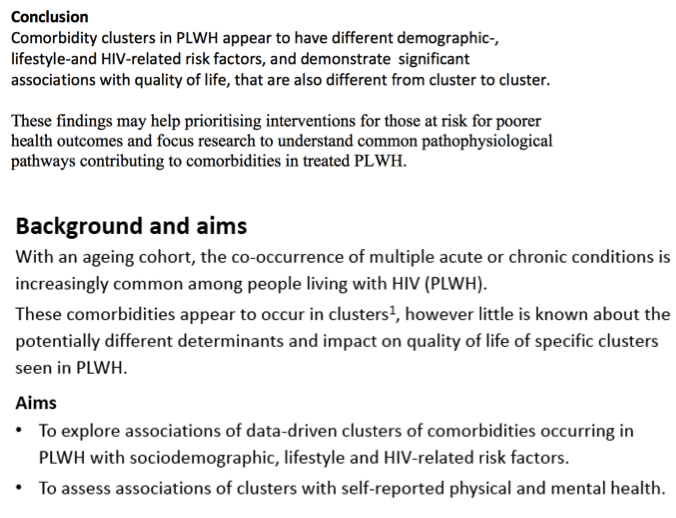
Program Abstract
Comorbidities in people living with HIV (PLWH) may occur in clusters, potentially affecting quality of life and general health in different ways. We explored associations of risk factors and patient reported health outcomes with common clusters of co-occurring comorbidities.
We considered 65 comorbidities reported by PLWH via a structured interview with trained staff. Principal component analysis was used to identify non-random clusters of co-occurring comorbidities and obtain a score for each cluster proportional to the number of comorbidities included in the cluster and present in an individual. Cluster scores were standardised (mean=0, SD=1), with higher scores indicating a greater number of comorbidities characterising a cluster. Multivariable median regression was then used to investigate associations of sociodemographic, lifestyle and HIV-specific factors with each cluster score. Multivariable linear regression was used to evaluate associations of cluster scores (independently of each other) with physical and mental health summary scores (obtained from SF-36 questionnaire, range 0-100).
In 1073 PLWH (85% male, 84% white ethnicity, median (IQR) age 52 (47-59) years) we identified 6 comorbidity clusters (Table). 'CVDs', 'metabolic' and 'chest/other infections' scores were independently associated with older age and longer time since HIV diagnosis (all p's<0.001). Higher body-mass index was associated with higher scores in the 'CVDs' (p=0.009), 'cancers' (p=0.03) and 'metabolic' clusters (p=0.006). PLWH with prior AIDS events had higher scores than PLWH without prior AIDS events for all clusters (p<0.05) except 'STDs'. Associations with smoking and alcohol consumption were weak across all clusters (all p's>0.05). Higher scores in the 'mental health' and 'chest/other infections' clusters were independently associated with poorer SF-36 physical (p's<0.001) and mental health scores (p<0.001 and p=0.03, respectively - Table). 'CVDs' and 'cancers' scores were associated with poorer physical (p=0.02, p=0.03) but not mental health (p's>0.05).
Comorbidity clusters in PLWH are associated with different demographic, lifestyle and HIV-related factors, and significantly impact on quality of life, particularly physical functioning. Identifying common comorbidity clusters in PLWH may help prioritise interventions for those at risk for poorer health outcomes and focus research to understand common pathophysiological pathways contributing to comorbidities in treated PLWH.
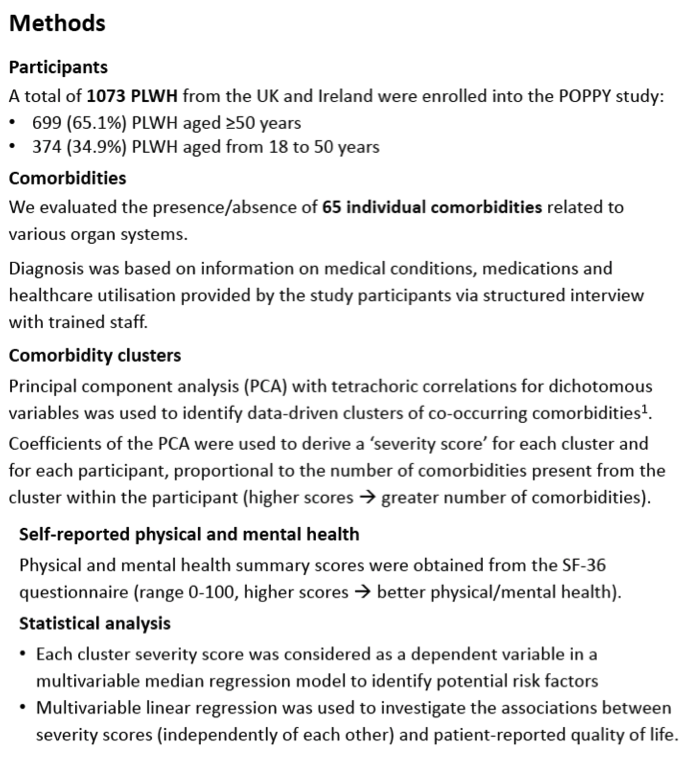
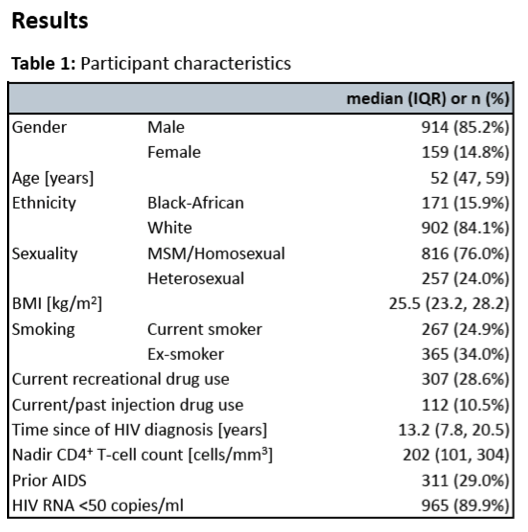

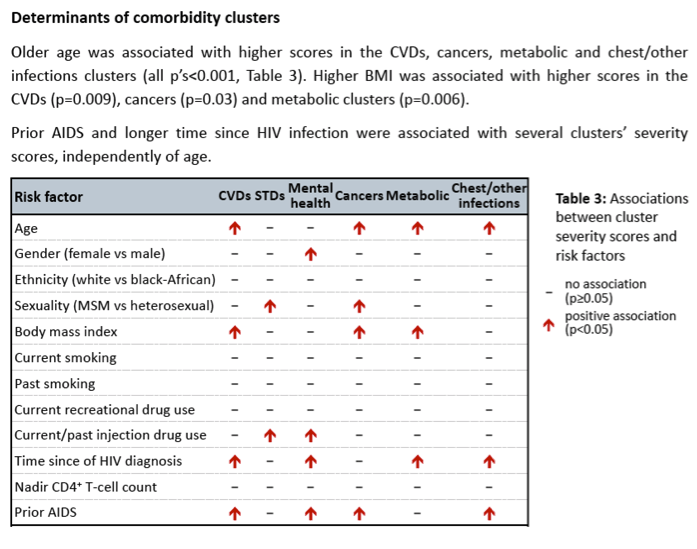
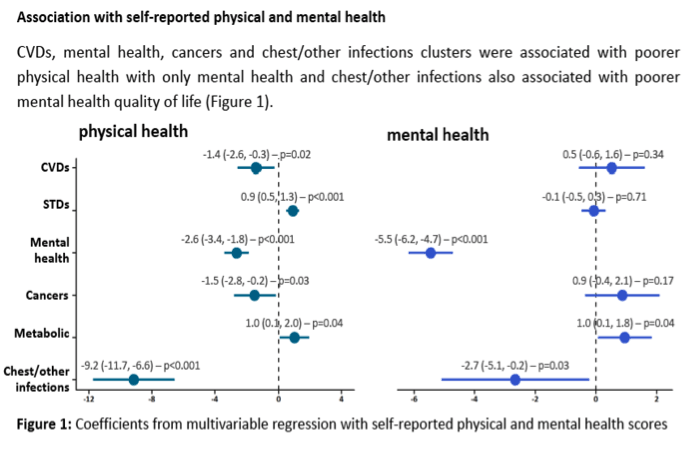
|
|
| |
| |
|
|
|